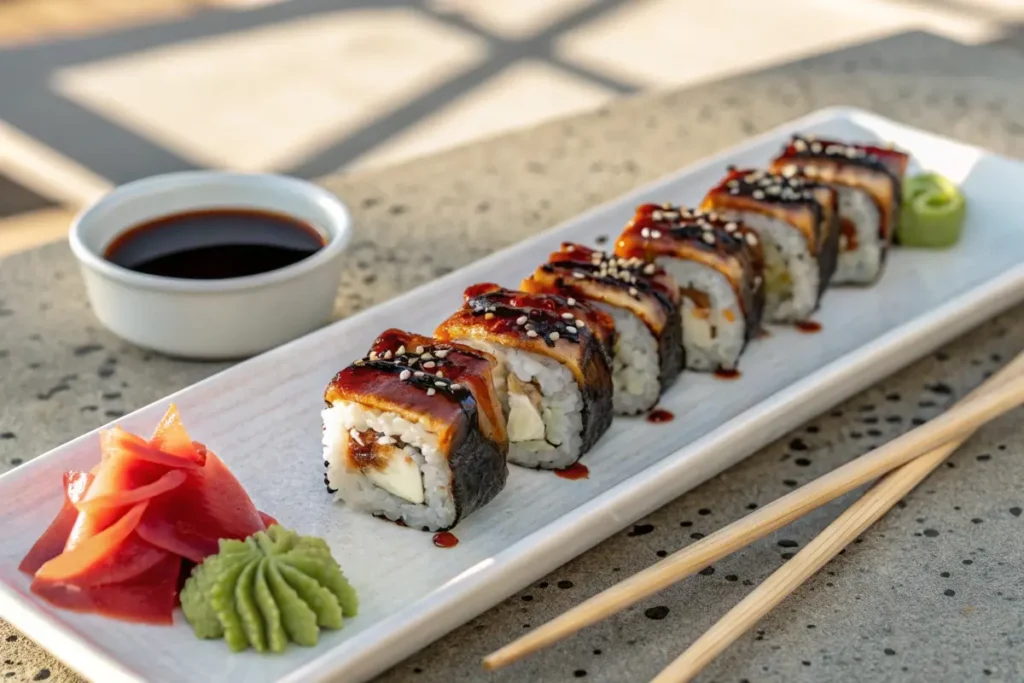If you’re on the hunt for a sushi roll that stands out both in appearance and taste, the black dragon roll is a must-try. Within the first few bites, you’ll notice its smoky undertones from dragon roll eel, paired with the rich creaminess of avocado. This roll isn’t just about looks—the contrasting dark sauce glaze and bright toppings offer an exciting visual. With so many creative sushi inventions available, the black dragon sushi roll still manages to remain a fan favorite. What’s in a black dragon roll? Typically, it combines crispy shrimp tempura or soft-shell crab on the inside, topped with slices of eel, and drizzled with unagi sauce for a deep, caramelized flavor. But that’s only the start of the story. In this guide, we’ll break down each element, compare it to the red dragon roll to see what sets them apart, and show you exactly why the black dragon roll has earned its place as a beloved sushi staple. If you’d like to explore more ways to pair your sushi dinner, consider checking out our Japanese Chicken Fried Rice Recipe to round out your meal with a classic side.
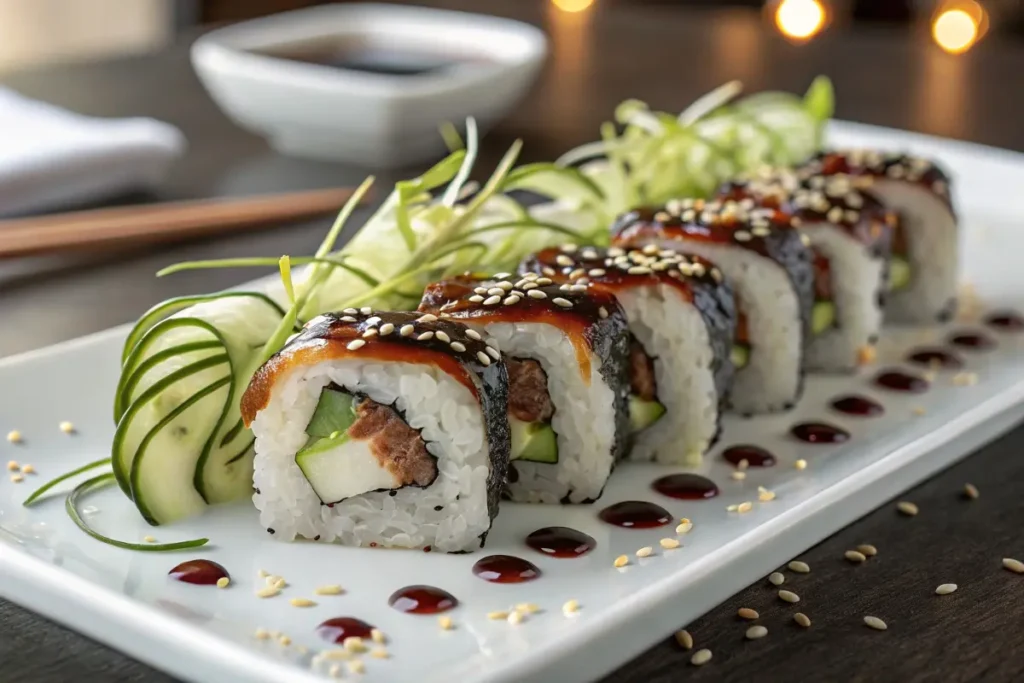
Table of Contents
The Essentials of the Black Dragon Roll
What Exactly Is a Black Dragon Roll?
A black dragon roll usually features a base of shrimp tempura or sometimes soft-shell crab within the roll, layered with cucumber or even avocado to add that cooling crunch. The top is typically adorned with eel (unagi), which is brushed with a sweet-savory unagi sauce—giving the roll a darker, glossy appearance and its “black” namesake. The contrast between warm eel, crisp tempura (or fried crab), and refreshing vegetables adds complexity to every bite.
Key Components
- Eel (Unagi): Often called the “star” of the black dragon sushi, eel provides a slightly sweet, smoky flavor. It’s commonly pre-cooked or grilled, then coated in unagi sauce (a thick, sweet soy-based glaze).
- Tempura Shrimp or Soft-Shell Crab: Adds a crunchy interior, balancing eel’s tenderness. Some variations might use crab sticks or spicy tuna inside, but the fried element is a classic approach.
- Avocado: Contributes a velvety mouthfeel, which pairs beautifully with crunchy or fried ingredients.
- Nori & Sushi Rice: The building blocks of most sushi rolls, ensuring structure and that signature vinegared taste.
- Unagi Sauce: Distinguishes the black dragon roll, painting the top eel slices with a rich caramel color.
Contrasting It with “Red Dragon Roll”
Wondering what is the difference between Red Dragon Roll and black dragon roll? The main variance: the red dragon roll often focuses on spicy tuna or a vibrant sauce, giving it a distinct red hue. The black dragon roll, meanwhile, centers on eel’s deep color, with unagi sauce as the finishing glaze. So if “red” highlights heat and raw fish, “black” zeroes in on the eel’s smoky-sweet profile.
Flavor Profile
- Sweet & Savory: Unagi sauce has a strong sweet note, balanced by a mild savory undertone from soy.
- Crunch & Cream: If the interior has tempura shrimp, you get a crisp first bite, followed by creamy avocado or cucumbers.
- Smoky Undertones: Grilled eel often picks up a faint char that resonates nicely with the sauce.
Why Is It Called a “Dragon” Roll?
In many sushi variations, “dragon” references the layered or scaly look, commonly from overlapping avocado slices or eel fillets on top. The final shape can resemble a mythical dragon, especially if a shrimp tail protrudes. For the black dragon version, the color from eel plus dark sauce is reminiscent of a mythical black dragon’s scales.
Versatility & Customization
You might encounter slight tweaks across sushi bars. Some incorporate spicy mayo for added heat or garnish with sesame seeds or roe (tobiko or masago) for texture. Essentially, the black dragon roll is a flexible concept: anything that complements eel’s smoky sweetness can fit in. You can also pair it with a side dish of miso soup or a tangy salad. For an innovative Japanese dinner, see our Japanese Scallop Recipe—scallops can offer another succulent seafood note on the table.
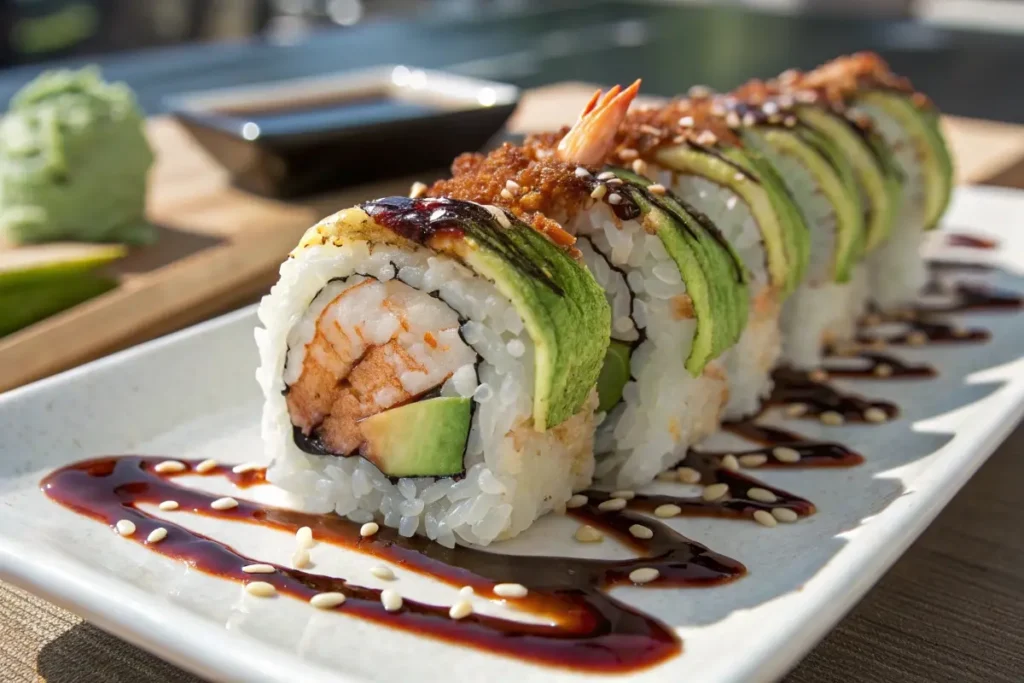
Ingredients & Variations
Core Ingredients
- Eel (Unagi): Usually pre-cooked, grilled eel. Found in many grocery stores or fish markets vacuum-sealed with sauce.
- Tempura Shrimp or Fried Soft-Shell Crab: The crunchy interior. Alternatively, some might swap for lightly battered vegetables or fish if they want a pescatarian-friendly version.
- Avocado & Cucumber: Avocado adds creaminess, cucumber delivers a fresh crunch. Both serve as a neutral foundation to highlight eel’s sweetness.
- Sushi Rice & Nori: Without them, we wouldn’t have the structure or the signature sushi tang.
- Unagi Sauce: A sweet-salty glaze made from soy sauce, sugar, and sometimes mirin. This finishing sauce is a non-negotiable for that “black” effect.
Optional Twists
- Spicy Mayo: If you crave a hint of spice, a drizzle of spicy mayo pairs well with eel’s sweetness.
- Sesame Seeds or Roe: Sprinkled on top for extra color and tiny pops of texture.
- Pickled Ginger: Often served on the side, cleansing the palate between bites.
- Alternate Fillings: Some chefs experiment with cream cheese or sweet potato tempura for a fusion spin on the “dragon roll eel” concept.
Black Dragon Roll vs. Red Dragon Roll
We’ve touched on their differences, but let’s clarify for those still curious: “What’s in Red Dragon Roll?” Typically, a red dragon roll features spicy tuna atop or inside, giving it a vibrant red hue, sometimes accompanied by chili or sriracha-based sauces. Conversely, black dragon leans on eel plus unagi sauce for deeper, darker shades. Both are “dragon” rolls but channel distinct flavor directions—heat and bright color vs. sweet smoky darkness.
Is the Dragon Roll Good?
According to many sushi enthusiasts, absolutely. But your preference depends on flavor tolerance for sweet-savory eel. If you love robust, caramelized profiles, you’ll likely find the black dragon roll irresistible. The balanced textural experience (crispy interior, tender eel topping) plus that luscious unagi sauce ranks it high among sushi menu favorites. If you want to try something similarly complex but with less sweetness, consider an alternate “dragon roll” variant like a green dragon (where avocado lines the top, minus the eel) or even a “rainbow roll” featuring multiple fish types.
Pairing Suggestions
Side Dishes
- Edamame: Salty steamed soybeans offset the sweet unagi sauce.
- Miso Soup: Classic synergy with sushi. The soup’s umami complements the rich roll.
- Seaweed Salad: The tangy-salty marinade cuts through the eel’s sweetness.
Beverages
- Green Tea: A cleansing beverage that refreshes the palate.
- Light Beer or Sake: Crisp drinks can mitigate the unagi sauce’s sweetness.
- Sparkling Water: Also works to keep your mouth fresh as you enjoy each piece.
For an even bigger sushi night spread, consider also serving a side of Japanese Radish Recipe pickles or tangy daikon for extra crunch. The tanginess plays nicely with the black dragon roll’s sweet-savory dynamic.
Home-Made vs. Restaurant
If you’re making a black dragon roll at home, you’ll want to gather the freshest eel you can find (or pre-packaged unagi), sushi-grade shrimp, plus the right sauce. The rolling technique is similar to other sushi: lay nori, spread rice, add fillings, roll tightly, and top with eel slices. Drizzle with unagi sauce, slice, and you’re ready. Restaurants might incorporate fancier plating, like tempura flakes or decorative wasabi paste. Regardless, the essence remains that signature eel-laced, sweet-savory vibe.
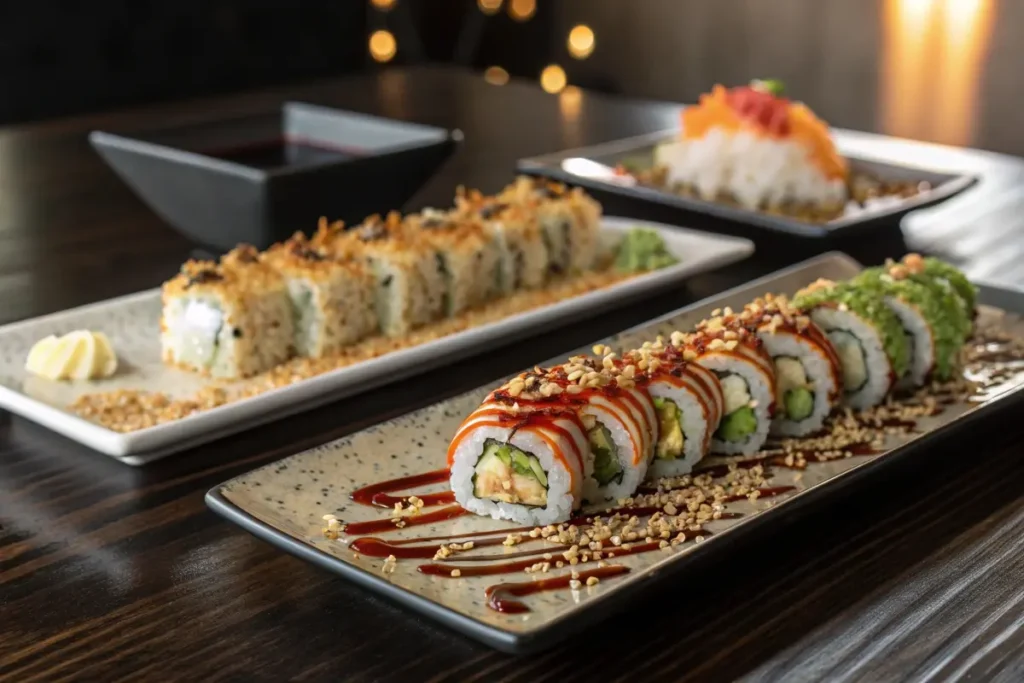
Rolling & Assembly Techniques
3.1 Prepping Your Ingredients
- Cook/Heat Eel: If your eel is frozen or pre-packaged, warm it in the oven or toaster oven until it’s soft and warm. Slice it lengthwise for topping each roll segment.
- Tempura Shrimp: Fry freshly battered shrimp or buy pre-cooked tempura from the market. Let it cool slightly so it remains crisp.
- Sushi Rice: Cook short-grain rice, season with vinegar, sugar, and salt. Keep it warm but not piping hot when assembling.
- Veggies: Slice cucumber into matchsticks, and avocado into thin slices (for the interior or garnish).
3.2 Setting up Your Station
A classic sushi-making setup involves:
- Bamboo Rolling Mat: Optionally wrapped in plastic to prevent rice sticking.
- Nori Sheets: Full or half-sheets, depending on how thick you want the roll.
- Bowl of Water: To keep your fingers moist, ensuring rice doesn’t cling.
3.3 Layering the Roll
- Rice Placement: Lay a half or full nori sheet on the mat, shiny side down. Spread sushi rice evenly, leaving a small border at the top edge for sealing.
- Filling: Place tempura shrimp (or soft-shell crab) horizontally. Add cucumber strips, maybe some avocado slices if you like it inside.
- Rolling: Lift the mat’s front edge, rolling it over the filling. Tuck firmly so it holds shape. Slightly wet the nori border to seal.
3.4 Topping with Eel & Avocado
Now for the “dragon” effect:
- Place Eel Slices: Carefully lay slices across the top of the roll, forming a continuous strip. If you want extra avocado on top, place thin avocado slices next to or overlapping the eel.
- Plastic Wrap or Foil: Some chefs place plastic wrap over the topping so it doesn’t shift. Then they press gently with the bamboo mat to mold everything snugly.
3.5 Unagi Sauce Drizzle
This is crucial for the sushi black dragon roll finishing touch. Drizzle or brush unagi sauce across the top eel. The sauce seeps into the gaps, ensuring a uniform “black” glaze. If you want to elevate it further, add sesame seeds or roes.
3.6 Slicing & Serving
- Knife Technique: Use a sharp, moistened knife. Slice the roll in half, then cut each half into 3-4 pieces. Clean the blade after each slice to maintain neat edges.
- Plating: Align pieces in a row, showing off the eel’s glossy top. Garnish with pickled ginger or wasabi on the side.
- Presentation: If you want a more dramatic “dragon” shape, arrange pieces in an S-curve, position shrimp tails or cucumber “dragon horns” at one end, and use sauce patterns around the plate.
3.7 Pro Tips
- Maintain Crispiness: If using tempura shrimp, avoid letting it sit too long before rolling—moisture can ruin the crunch.
- Uniform Topping: Slice eel carefully so each sushi piece gets a portion.
- Testing: First roll might be tricky. With practice, you’ll adjust rice amounts and topping spacing for perfect cuts.
- Pairing: Try using your leftover eel or sauce to top an Eel Dragon Roll Sushi variation or create a fusion dish. If you crave variety, a side of Japanese Vegan Recipes can introduce fresh vegetables or tofu-based sides to balance the eel’s richness.
With these techniques, your homemade black dragon roll can rival restaurant quality. The crisp-fried core, soft eel slices, and glistening sauce create a feast for the eyes and palate—everyone’s bound to be impressed when you unveil this showstopper roll.
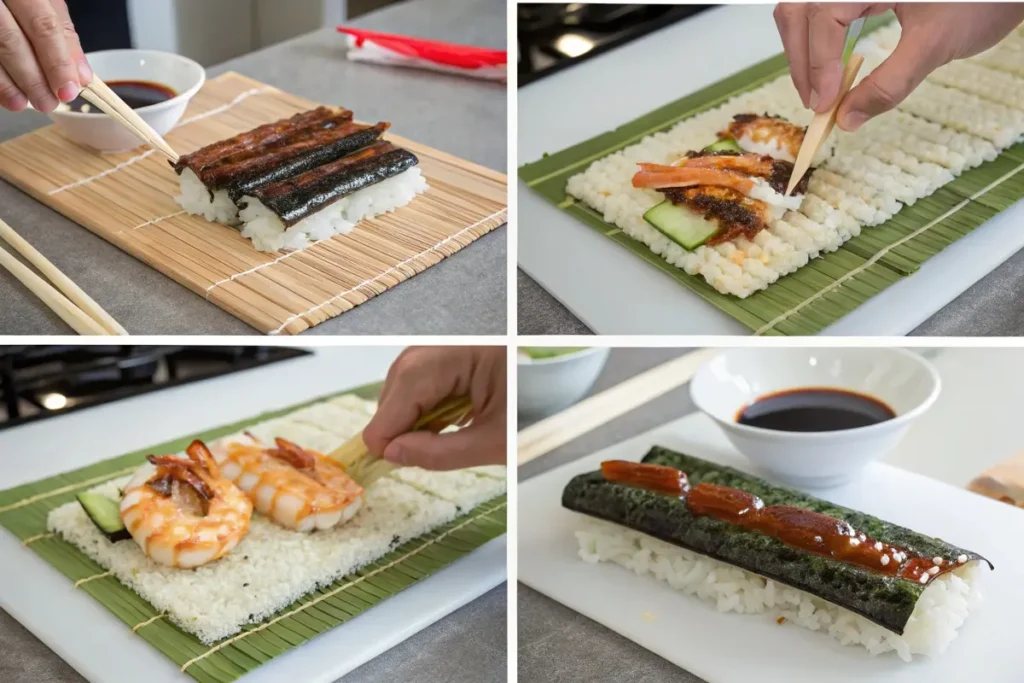
History and Context
4.1 Dragon Rolls Emergence
Sushi in Japan historically revolved around nigiri or simpler maki. More elaborate “rolls” are often considered Western-influenced or “fusion sushi.” Rolls like the California roll or spider roll introduced unique ingredients—avocado, soft-shell crab, mayonnaise—to Western palates. The “dragon roll” phenomenon rose as restaurants sought visually dramatic items to stand out. Topping a roll with slices of fish or eel—arranged to mimic a dragon’s scales—became a signature trick. The black dragon roll, specifically featuring eel’s deep hue, turned heads for its boldness and sweet-savory punch.
4.2 Eel as a Delicacy
In Japan, unagi (freshwater eel) has been cherished for centuries, believed to offer stamina and nutritional benefits. Eel is commonly grilled and brushed with sauce during summer months, especially around the Day of the Ox in midsummer (Doyo no Ushi no Hi). Introducing eel into creative sushi rolls expanded its global popularity. Western diners typically found unagi’s sweet, smoky taste accessible. This acceptance spurred new “dragon roll eel” variations that capitalized on eel’s unique flavor and color.
4.3 The Black Dragon Roll’s Rise
With sushi’s international boom, chefs got creative naming or styling their menu items. “Black dragon roll” emphasizes unagi sauce’s dark glaze on top, contrasting bright interior fillings. Over the late 1990s and early 2000s, as sushi shops multiplied across North America and Europe, the black dragon roll became a staple. Fans adored how you got both crunchy texture (tempura or fried crab) and silky eel in each slice—arguably more indulgent than simpler shrimp or salmon-based rolls.
4.4 Evolution in Presentation
In many modern sushi bars, you’ll see extravagantly plated black dragon rolls. Some arrange the pieces in serpentine shapes, garnish them with togarashi (chili flakes) or gold leaf for extra drama. Others rely on minimalistic plating to let the glossy black sauce speak for itself. Over time, spinoffs emerged, like combining eel with spicy tuna or layering multiple fish for a more rainbow-like effect. But the black dragon’s identity always remains tied to eel’s luscious, dark-sauced topping.
4.5 Global Influence
Now, even if you dine in a sushi restaurant in Europe, Australia, or parts of Asia outside Japan, you might spot a black dragon roll on the menu. This cross-continental acceptance showcases how fusion sushi, once seen as unorthodox, has become integral to global culinary culture. It stands alongside other “creative rolls” like the red dragon, green dragon, rainbow roll, or volcano roll in bridging Eastern tradition with Western flair. If you’d like a deeper glimpse into Japanese ingredient evolution, check out our Japanese Curry Recipe One Piece to see how dishes adapt across cultures. The black dragon roll similarly exemplifies sushi’s endless adaptability.
Practical Examples/Use Cases
5.1 Home Sushi Night
Want to impress dinner guests with something beyond a basic California roll? Black dragon roll is the showstopper. Prep eel in advance, fry up shrimp tempura, and roll away. The combination of textures draws praise—everyone loves the crunchy inside paired with sweet eel. For variety, pair it with a simpler cucumber roll or Vegetables Japanese Recipe side dish. This contrast ensures a full range of flavors on the table.
5.2 Restaurant Signature Item
Running a sushi bar? The black dragon roll can easily become a signature dish, especially if you top it with refined garnishes like microgreens or a drizzle of spicy mayo swirl around the plate. The striking black glaze fosters social media posts—diners love snapping that perfect shot. Label it clearly on the menu as a specialty roll. It might be more premium priced, given the eel factor and labor intensity.
5.3 Catering & Events
Sushi caterers often feature “dragon rolls” for events. The “black” version stands out in buffets or sampling platters. Bite-sized pieces arranged in a serpentine line with sauce zigzags across the top create visual drama. Add small signs or place cards describing the eel topping so guests know this is no ordinary sushi. The sweet sauce pairs well with lighter champagne or white wine often served at receptions.
5.4 Cooking Classes
If you’re teaching sushi-making, demonstrating a black dragon roll can highlight advanced topping techniques. Beginners see how layering eel slices transforms a basic roll into something extraordinary. They also learn controlling sticky sauce application. The sense of achievement from rolling a successful black dragon encourages more sushi experimentation.
5.5 Special Occasions
For birthdays, anniversaries, or even casual weekend gatherings, unveiling a black dragon roll impresses. Its bold color, luscious eel, and meticulous arrangement make it feel celebratory. Combine it with sweet endings like mochi ice cream or Traditional Japanese Desserts Recipe for a well-rounded feast. Because sushi often denotes freshness and craft, it elevates any event to a more refined level.
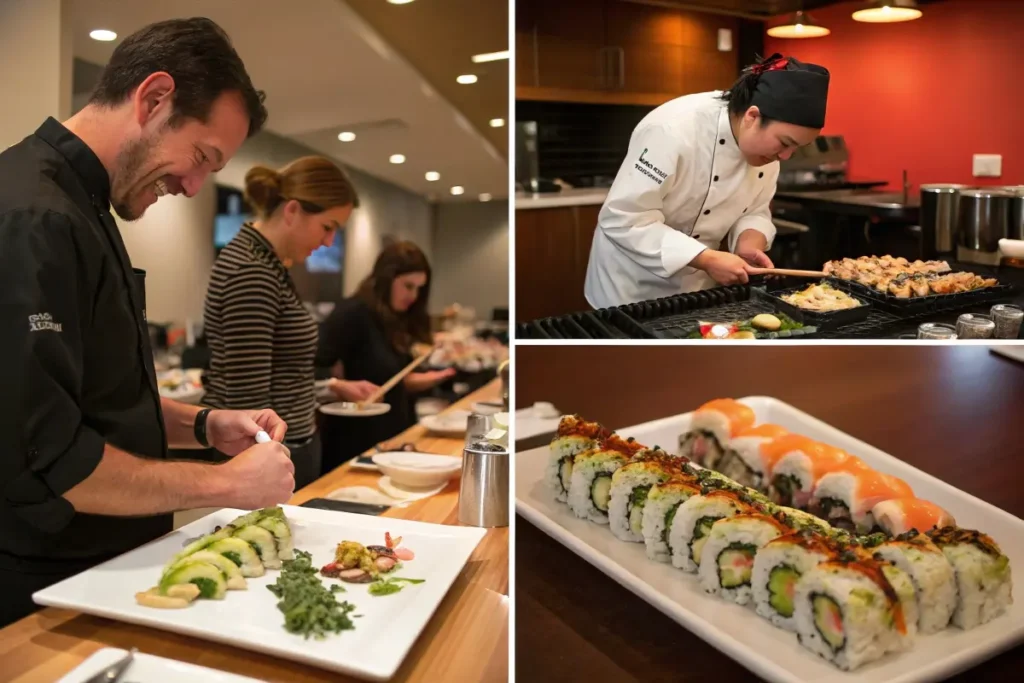
FAQs
1. What is in a black dragon roll?
A black dragon roll generally contains shrimp tempura or fried soft-shell crab on the inside, plus cucumber or avocado. On top, you’ll find slices of grilled eel (unagi) drizzled with unagi sauce, giving that characteristic dark appearance.
2. What is the difference between Red Dragon Roll and black dragon roll?
Red dragon rolls typically feature spicy tuna or a bright chili-based sauce, lending them a reddish hue. Meanwhile, black dragon rolls rely on eel and unagi sauce for a deeper, caramelized color. Flavor-wise, red dragon rolls can be spicier, whereas black dragon rolls lean on sweet-savory eel profiles.
3. What’s in Red Dragon Roll?
Though variations exist, a red dragon roll usually sports spicy tuna inside, topped with more tuna or a chili sauce, providing that “red” effect. Some versions add tempura crumbs or spicy mayo for extra punch.
4. Is the dragon roll good?
Yes, many sushi fans love the “dragon roll” family for its layering of textures and flavors. The black dragon version is particularly popular for pairing crisp fried elements with the sweet, smoky taste of eel. If you enjoy unagi or sweet sauces, you’ll likely find it delicious.
5. Which fish is used in a black dragon sushi roll?
Eel is the star fish topping. Inside, you might have shrimp or crab, but the eel on top is what distinguishes the roll as a “black dragon” due to the unagi’s dark glaze.
6. How does an eel dragon roll sushi differ from black dragon sushi?
They are often synonymous. “Eel dragon roll” typically describes any roll topped with eel slices. “Black dragon sushi roll” specifically highlights the color from the unagi sauce. In practice, sushi bars might label them slightly differently, but the concept is similar.
7. Any good side dishes for black dragon roll?
Yes. Miso soup, seaweed salad, or even Japanese Desserts if you’d like a sweet finish. The combination ensures a balanced meal around your feature sushi roll.
Conclusion
The black dragon roll stands out in the sushi world for its visually striking eel topping, a luscious drizzle of unagi sauce, and that crunchy-fried contrast within. Whether you prefer a succulent shrimp tempura center or a crisp soft-shell crab, pairing it with sweet-savory eel highlights why this roll remains a top choice on many sushi menus. If you’ve been curious about the differences between red and black dragon rolls or wanted a deeper look at how unagi sauce transforms basic fillings into a show-stopping dish, hopefully this guide has answered your questions.
From detailed rolling tutorials to flavor pairings and historical insights, the black dragon roll consistently proves its versatility. You can keep it classic, or add your own flair through garnish tweaks and sauce combos. If you’re eager to explore more Japanese-inspired recipes beyond sushi, check out our Japanese Chicken Curry Recipe for another flavorful main course. Above all, remember that sushi is about creativity, freshness, and a balance of textures—and the black dragon roll truly embodies all three. Whether dining out or rolling at home, embracing the sweet-smoky essence of eel is sure to enhance your sushi experience.
